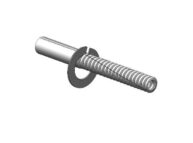Residual Torsional Stress: The Silent Killer
By: Hose Master | On: January 21, 2025


Residual torsional stress is a by-product of the helical forming process, evident by the hose’s visibly-twisted seam weld.
Why Stress over Residual Torsional Stress?
It’s no secret that torque is a killer for metal hoses. If you’ve ever attended Hose Master University, you’ve probably heard our corporate trainer’s well-known adage- “Don’t twist the hose!” You want to avoid torsional stresses completely in all metal hose assemblies. When we inspect corrugated metal hoses and look for torsional stress, it’s typically after installation while the hose is in service. However, we should also be concerned with torsion that can happen before installation during the manufacturing process. This is referred to as residual torsional stress.
Residual torsional stress (RTS) is problematic because it accelerates fatigue to the metal, thus reducing the ultimate service life of the hose. A key indication of RTS is when a hose has a visibly twisted seam weld. Despite the issues created by RTS, it is inherent in many hose-forming processes used today. The only way to prevent RTS in metal hoses is by avoiding the use of manufacturing methods that cause it. Let’s explore some of the ways residual torsional stress can be created during manufacturing.
Helical Forming & Cam Forming

Although it creates annular corrugations, cam forming produces a similar twisted seam weld to helical forming.
Helical forming is a common method for making metal hoses. It works by using a round disc that is twisted around the outer diameter of a tube to create a continuous helical corrugation. Because it is a continuous and inexpensive method for making hose, it can initially present itself as a desirable option. However, once you look past its initial cost savings, there are few other benefits to helical forming. Along with the RTS present in helical-formed hoses, even more stress is applied to the metal when the hose is pressurized, causing the helical corrugations to twist in an effort to straighten out. Because of this, a helical-formed hose is typically not a long-lasting solution.
Cam forming is similar to the helical forming method. Cam forming functions in much the same way as helical forming, except that the disc rotating around the tube to create the corrugations is split, thus creating annular corrugations. However, like helical forming, cam forming still twists the tubing while forming the corrugations, creating the familiar twisted seam weld we associate with residual torsional stress.
While the utilization of helical or cam forming can be inexpensive in the short run, hoses made from these methods ultimately provide poor long-term cost savings. Due to their shorter service life, cam-formed or helical-formed hoses need to be replaced more frequently, which can add to material and labor costs. Therefore, it is important to consider a hose’s longevity when evaluating long-term cost-effectiveness and what will ultimately create greater value for the customer.
A RTS-Free Metal Hose Solution
Given the prominence of residual torsional stress in corrugated metal hose manufacturing methods and its detrimental effect on hose performance, it’s important to remember that not all hoses are created equal. While some forming methods are notorious for creating residual torsional stress, there are others that can avoid this problem completely. Because Hose Master’s hose is axially fed during manufacturing, we can effectively eliminate residual torsional stress to provide you with a longer-lasting, more cost-effective product.
If you’re tired of replacing torqued hoses, why not try something different? Visit one of our trusted distribution partners to find a solution near you, or contact us with any application-specific concerns you may have.

